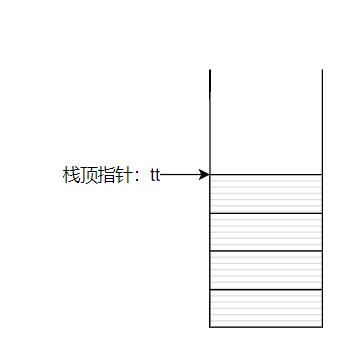栈
模拟栈
栈的特点:先进后出

数组模拟栈的方法:
tt 指针指向栈顶
插入:tt 指针++
弹出:tt 指针--
判断栈空:tt == 0 ?
询问栈顶元素:stk[tt]
例题
#include <iostream>
#include <string>
using namespace std;
const int N = 1e5 + 5;
int stk[N], tt;
int main()
{
int T, x;
string op;
cin >> T;
while(T--)
{
cin >> op;
if(op == "push")
{
cin >> x;
stk[++tt] = x;
}
else if(op == "pop")
{
--tt;
}
else if(op == "empty")
{
if(tt == 0) cout << "YES\n";
else cout << "NO\n";
}
else
{
cout << stk[tt] << endl;
}
}
return 0;
}
表达式求值
算法:转换为逆波兰表达式(后缀表达式),工程上往往转换完成后进行计算,其实可以边转换边计算。
首先需要有两个栈:
stack<int> num:数字栈stack<char> op:操作栈
- 从左到右遍历表达式字符串,如果是数字则压入数字栈
- 如果是左括号
(压入操作栈 - 如果是右括号
)不压入栈- 遍历操作栈,从中弹出操作符,直到遇到左括号
(停止 - 从数字栈中弹出两个操作数,注意操作数的顺序相反
- 将计算结果压入数字栈
- 将左括号
(弹出操作栈
- 遍历操作栈,从中弹出操作符,直到遇到左括号
- 如果是操作符
- 遍历操作栈,当栈非空,栈顶不为左括号,栈顶操作符的优先级大于当前操作符时:从操作栈中弹出操作符,从数字栈中弹出两个操作数进行计算,并将结果压入数字栈中。
- 将当前操作符压入栈中
- 当表达式遍历完成后,将剩余的操作符计算完成,结果存放在数字栈中,
num.top()即为计算结果
例题
#include <iostream>
#include <cstring>
#include <string>
#include <stack>
#include <algorithm>
#include <unordered_map>
using namespace std;
stack<int> num;
stack<char> op;
void cal()
{
int b = num.top(); num.pop();
int a = num.top(); num.pop();
int p = op.top(); op.pop();
int c = 0;
if(p == '+') c = a + b;
else if(p == '-') c = a - b;
else if(p == '*') c = a * b;
else if(p == '/') c = a / b;
num.push(c);
}
int main()
{
unordered_map<char, int> pr = {{'+', 1}, {'-', 1}, {'*', 2}, {'/', 2}};
string str;
cin >> str;
int n = str.length();
for(int i = 0; i < n; ++ i)
{
char c = str[i];
if(isdigit(c))
{
int x = 0, j = i;
while(j < n && isdigit(str[j]))
x = x * 10 + str[j ++ ] - '0';
i = j - 1;
num.push(x);
}
else if(c == '(') op.push('(');
else if(c == ')')
{
while(op.top() != '(') cal();
op.pop();
}
else{
while(!op.empty() && op.top() != '(' && pr[op.top()] >= pr[c])
cal();
op.push(c);
}
}
while(!op.empty()) cal();
cout << num.top() << endl;
return 0;
}
本文来自博客园,作者:xiongyuqing,转载请注明原文链接:https://www.cnblogs.com/xiongyuqing/p/15095768.html


